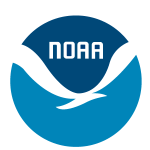- Industria: Government
- Number of terms: 30456
- Number of blossaries: 0
- Company Profile:
NOAA Coral Reef Conservation Program, National Oceanic and Atmospheric Administration, U.S. Department of Commerce
A representation of the measurement of energy emitted or reflected by the Earth in a variety of wavelengths. Earth observation imagery takes a number of forms, of which the most traditional are optical and near-infrared radiation, from about 0.4 (blue) to 2.0 (IR) micrometers. Apart from visual and near-infrared, other bands of the spectrum commonly used include thermal infrared (heat) and microwave (radar). Each of these has its own applications.
Industry:Natural environment
A supportive or protective structure or framework of an animal, a plant, or part of an animal or plant. In animals it is an external (exoskeleton) or internal (endoskeleton) support structure, against which the force of muscles acts. Vertebrates have a skeleton of bone or cartilage; arthropods have one made of chitin; corals have one of calcium carbonate: sponges have a mass of spicules; many other invertebrates use a hydrostatic skeleton, which is an incompressible fluid-filled region of their body. In plants, the skeleton may be a rigid protective covering, as in the shell of a diatom, or the vascular system of a vascular plant.
Industry:Natural environment
An abnormal passage between two organs or between an organ and the outside of the body. Fistulae are caused by ulceration, congenital malformation, or when damaged tissues come into contact with each other and join together while healing.
Industry:Natural environment
The force per unit area exerted by the weight of water. Each 33 feet of sea water exerts a pressure equivalent to one atmosphere, or 14.7 psi.
Industry:Natural environment
An organism which carries or transmits a pathogen; a vehicle that transfers genetic material into a host cell or organism. Typically, vectors are of two types: viral- or DNA-based. DNA vectors are automously replicating, circular macromolecules that can be easily manipulated to carry genetic information and are transferred into cells by standard laboratory techniques. These vectors include plasmids, cosmids, and yeast artificial chromosomes (yacs). Recombinant viruses that have been bioengineered to be harmless can also carry new genetic information for transfer into cells, or into an entire host organism (an example of gene therapy) .
Industry:Natural environment
In cephalopods, one of two chitinous mandibles (jaws) used primarily to cut prey tissues during feeding.
Industry:Natural environment
Text or images on a Web page that, when clicked with a mouse, causes the browser to load another page of HTML. Because a simple mouse click allows the user to easily go from one page of hypertext to another, these pages are said to be "hyperlinked." Text links are usually, but not always underlined in blue, while hyperlinks that are images often take the form of "buttons".
Industry:Natural environment
The first page that a browser opens when accessing a Web address (URL). The home page generally serves as a gateway to the rest of the Web site by providing links to the other pages.
Industry:Natural environment
The area drained by a river or body of water; also called "drainage basin".
Industry:Natural environment
